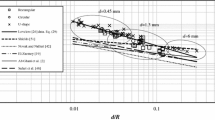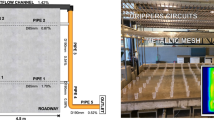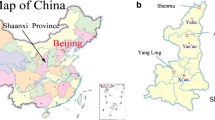Abstract
This paper examines the experimental study on influence of material component to non-linear relation between sediment yield and drainage network development completed in the Lab. The area of flume drainage system is 81.2 m2, the longitudinal gradient and cross section slope are from 0.0348 to 0.0775 and from 0.0115 to 0.038, respectively. Different model materials with a medium diameter of 0.021 mm, 0.076 mm and 0.066 mm cover three experiments each. An artificial rainfall equipment is a sprinkler-system composed of 7 downward nozzles, distributed by hexagon type and a given rainfall intensity is 35.56 mm/hr.cm2. Three experiments are designed by process-response principle at the beginning the ψ shaped small network is dug in the flume. Running time spans are 720 m, 1440 minutes and 540 minutes for Runs I, IV and VI, respectively. Three experiments show that the sediment yield processes are characterized by delaying with a vibration. During network development the energy of a drainage system is dissipated by two ways, of which one is increasing the number of channels (rill and gully), and the other one is enlarging the channel length. The fractal dimension of a drainage network is exactly an index of energy dissipation of a drainage morphological system. Change of this index with time is an unsymmetrical concave curve. Comparison of three experiments explains that the vibration and the delaying ratio of sediment yield processes increase with material coarsening, while the number of channel decreases. The length of channel enlarges with material fining. There exists non-linear relationship between fractal dimension and sediment yield with an unsymmetrical hyperbolic curve. The absolute value of delaying ratio of the curve reduces with time running and material fining. It is characterized by substitution of situation to time.
Similar content being viewed by others
References
Schumm S A. The Fluvial System. New York: Wiley, 1977. 338.
Horton R E. Erosional development of streams and their drainage basins: hydrophysical approach to quantitative morphology.Geol. Soc. Amer. Bull., 1945,56: 275–370.
Leopold L B, Langbein W B. The concept of energy in landscape evolution,US Geol. Survey, Prof. Paper. 1962, No. 500-A, 20.
Langbein W B, Leopold L B. Quasi-equilibrium state in channel morphology.Amer. J. Sci., 1964, 262: 782–794.
Shreve R L. Statistical law of stream numbers.J. Geol., 1966,74: 17–37.
Shreve R L. Infinite topologically random channel networks.J. Geol., 1967,75: 179–186.
Shreve R L. Stream length and basin areas in topologically random channel networks.J. Geol., 1969,77: 397–414.
Smart J S. Topological properties of channel networks.Geol. Soc. Amer. Bull., 1969,80: 757–774.
Smart J S. The random model in fluvial geomorphology. In: Marie Morisawa (ed). Fluvial Geomorphology, Publications in Geomorphology, State University of New York, Binghamton, New York, 13901, 1973. 314.
Scheidegger A E. Random graph patterns of drainage basins.Inter. Assoc. Sci. Hydro. Pub., 1967,76: 415–425.
Scheidegger A E. A stochastic model for drainage patterns into an intramantane trench.Bull. Intern. Asso. Sci. Hydro., 1967,12: 636–638.
La Barbera P, Rosso R. On fractal dimension of stream networks.Water Resour. Res., 1989,25(4): 735–741.
Gupta V K, Waymire E. Statistical self-similarity in river networks parameterized by elevation.Water Resour. Res., 1989,25 (3): 463–476.
Robert A, Roy A G. On the fractal interpretation of the mainstream length drainage area relationship.Water Resour. Res., 1990,26 (5): 839–842.
Mesa O J, Gapta V K. On the main channel length-area for channel networks.Water Resour. Res., 1987,23(11): 2119–2122.
Ross R B, Bachi, Barbara P La. Fractal relation of mainstream length to catchment area in river networks.Water Resour. Res., 1991,27(3): 381–387.
Tanzhou Luo. Fractal structure and properties of stream networks.Water Resour. Res., 1992,28(110): 2981–2988.
Nikora V I. Fractal structures of river plan forms.Water Resour. Res., 1991,27(6): 1327–1333.
Feng Ping. Calculation on fractal dimension of river morphology.Acta Geographica Sinica, 1997,52(2): 324–330.
Jin Desheng, Chen Hao, Guo Qingwu. A preliminary study on non-linear properties of channel longitudinal profile.Acta Geographica Sinica, 1997,52(2): 154–161.
Tarboton D G, Bras R L, Rodriguez-iturbe I A. Physical basis for drainage density.Geomorphology, 1992,5(1-2): 59–76.
Li Houqiang, Ai Nanshan. Fractal geomorphology and fractal model of landform evolution.Nature Journal, 1992,15(7): 516–518.
Fu Jun, Ding Jin, Deng Yuren. A fractal study on drainage feature and water discharge diagram in Jialingjiang River Basin.Journal of Chengdu University of Science and Technology, 1995,1.
Chen Shuqun, Qian Lunhai, Feng Zhiwei. Fractal dimension of river pattern in Taiwan region. Chinese Taibei,Chinese Journal of Civil and Water Conservancy Engineering, 1995,7(1): 63–71.
Wei Yiming, Jin Juliang, Zhou Chenghu,et al. The time series fractal characteristics of inundated area of flood disaster occurred in China from 1949 to 1994.Journal of Natural Disasters, 1998,7(1): 83–86.
Feng Jinliang, Zhang Wen. Geometric features of modern Luanhe River Delta evolution.Journal of Oceanography of Huanghai & Bohai Seas, 1997,15(3): 22–25.
Feng Jinliang, Zhang Wen. River natural fractal of Haihe and Luanhe River drainage basin.Journal of Sediment Research, 1999, (1): 62–65.
Feng Jinliang, Zhang Wen. The evolution of the modern Luan-He River delta, North China.Geomorphology, 1999,25(3-4): 269–278.
Wang Fuqiang. A study on laws for fractal and self-organization in sediment movement and river bed evolution. Dissertations of Sichuan University, 1999, 106.
Roger Mousa, Is the drainage network a fractal Sierpinski space?Water Resour. Res., 1997,33(10): 2399–2408.
Jin Desheng, Chen Hao, Guo Qingwu. A preliminary experimental study on non-linear relation of sediment yield to drainage network developmentInternational Journal of Sediment Research, 1999,14(2): 9–18.
Strahler A N. Dimensional analysis applied to fluvial eroded landform.Geol. Soc. Amer. Bull., 1958,69: 279–300.
Schumm S A, Mosley M P, Weaver W E. Experimental Fluvial Geomorphology. New York: John Wiley and Sons, 1987. 413.
Jin Desheng, Liu Shulou, Guo Qingwu. A Study on Experiments and Simulations of Application to Fluvial Geomorphology. Beijing: Seismic Press, 1992. 98.
Jin Desheng, Guo Qingwu. An experimental study of development processes with uniform material. In: Jin Desheng ed. Experiments and Simulations in Geomorphology. Beijing: Seismic Press, 1995. 79–101.
Jin Desheng, Guo Qingwu. Problems about experimental similarities in the model of fluvial geomorphologic system. In: Jin Desheng ed. Experiments and Simulations in Geomorphology. Beijing: Seismic Press, 1995. 265–268.
Straggler A N. Quantitative analysis of watershed geomorphology.Am. Geography. Union Trans., 1957,38: 913–920.
Zhang Jie, Bao Haosheng. Fractal geomorphology: review and prospect.Geogr. Res., 1994,13 (3): 104–111.
He Longhua, Zhao Hong. The fractal dimension of river networks and its interpretation.Scientia Geographica Sinica, 1996,16 (2): 124–128.
La Barbera P, Rosso R. On the fractal dimension of stream networks.Water Resour. Res., 1989,25 (4): 735–741.
Author information
Authors and Affiliations
Corresponding author
Rights and permissions
About this article
Cite this article
De-sheng, J., Hao, C. & Qing-wu, G. Material component to non-linear relation between sediment yield and drainage network development: an flume experimental study. J. Geogr. Sci. 11, 271–281 (2001). https://doi.org/10.1007/BF02892310
Received:
Accepted:
Issue Date:
DOI: https://doi.org/10.1007/BF02892310




